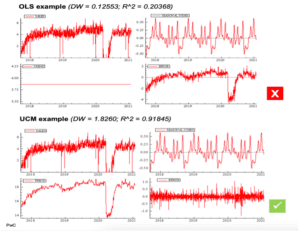Presented by: PricewaterhouseCoopers & Marketscience April-May 2021



Recently, top tier consulting firm, PricewaterhouseCoopers (PwC), and advanced marketing analytics consultancy, Marketscience, had the pleasure of presenting together to ISBA members on the impact that COVID-19 has had on measuring marketing effectiveness. Marketscience & PwC have worked together for years, deploying customized, advanced Marketing Mix Modeling (MMM) solutions for their shared F500 clients. The two companies have spent the last year analyzing COVID’s impact and advising clients on the proper modeling techniques to control for this “black swan” event.
It’s well known that COVID-19 has had major impacts on consumer demand and marketing strategy. As always, there have been winners and losers, with COVID impacting industries in a myriad of ways. Some have been grounded (e.g. aviation) or shut down (e.g. hospitality), while other segments have seen relatively robust consumer demand (e.g. FMCG, supermarkets, etc.). On top of COVID, there are additional elements that have impacted supply, demand, and customer sentiment, such as Brexit, social movements and consumer trends. When it comes to spending, 2020 saw reduced media spend across most channels and industries. For those who continued to invest, their marketing mix, creative messaging, and split between brand & performance were all likely to have changed.
As a result of these changes, a trifecta of frequently asked questions regarding optimal marketing measurement emerged. Can I use my existing model results to forecast budgets? Is it worth the time or money to model during COVID and the recovery? How do we ensure that we’re modeling the impacts of COVID correctly? These questions remain top-of-mind for any data driven, analytics focused company. “We really appreciate ISBA hosting a series conversation on the role of modeling in COVID and thank the audience for great questions and openness to a proper technical discussion” states Dr. Peter Cain, executive partner at Marketscience. Below are the answers provided by PwC & Marketscience in their ISBA presentation.
Can I use my existing Marketing Mix Model (MMM) results to forecast budgets?
If your organization stopped modeling at the onset of COVID and hasn’t updated results for over a year, the answer is probably not. At the start of the pandemic, it could have been possible to make reasonable assumptions about how COVID has impacted certain businesses marketing opportunities. For example, we knew that people were spending more time and money online (meaning potential for digital channel curves to increase) and that people were inside, watching more TV (meaning TV curves could also increase). However, with over one year having passed since the onset of COVID, consumer demand and marketing investment strategy have been so impacted that these assumptions no longer provide a robust assessment moving forward.
In order to accurately understand the shift in consumer response to advertising and base sales, models will need to be updated. Once the model updates have begun, they should continue to be updated consistently in order to measure and track these shifts over time.
Is it worth it to model during COVID-19/ the recovery?
With such volatility in this past year’s data, it’s natural to wonder whether it’s even worth it to model during COVID. The answer, however, is overwhelmingly yes!
Modeling throughout COVID and the recovery is critical to understand the impact this past year has had on consumer demand. Using past data is relevant, and even required for an MMM to accurately gauge impact and analyze the extent of the disruption. A marketing mix model will help you understand the immediate short-term effect of events like store closures, supply chain disruption and the switch from offline to online sales. It can also help you to better understand the longer-term effects of customer shopping behavior and whether demand will return to prior levels. Despite the disruption in sales, it’s important to continually track the value & growth of your brand. Other brand and demand drivers that can be measured include long-term base sales, brand impact, price elasticity, customer experience, and promotions.
As you start to rebuild your business, having the latest data (captured over the past year) and insight on what’s working and what’s not, will be critical to success. This is especially true if your brand and marketing strategy has drastically shifted in the past year.
How do we ensure we model the impacts of COVID-19 correctly?
Accurately modeling COVID’s impact requires the use of a flexible measurement technique that can control for the exogenous shock of COVID and isolate its short and long-term effects. Such a technique is crucial because it utilizes past data and allows your business to understand whether COVID’s impact was a short-term transitory effect (affecting sales), or a longer-term structural one (affecting sales and brand value).
Classical approaches to MMM are ill-suited to control for exogenous shocks like COVID-19. Such models are focused only on short-term outcomes, assume fixed and deterministic baseline behavior and are unable to differentiate between short and long-term impact.
The Marketscience & PwC solution is an Unobserved Component Model (UCM), otherwise known as a state space econometric technique, which can model both the short and long-term behavior simultaneously, control for the COVID break, and enable vector error correction models (VECM) to understand the impact on longer-term brand building effects. Capturing the long-term component is vital, as it enables an organization to understand why the brand and business is behaving as it is and whether there has been a discernable shift in consumer buying behavior, which is indicative of a long-term effect on consumer attitudes.

As shown in the top graphs of the figure, traditional Ordinary Linear Square (OLS) approaches have no dynamic base control and load COVID-19 effects into the error, thus invalidating results. Such standard approaches like this would argue that you just need to find the correct controls to arrive at well-behaved residuals - but this is a very difficult task.
A UCM approach (bottom graphs) removes the systematic variation from the error, thus allowing for correct model inference. Such an approach allows for a pre- and post-COVID analysis and assesses whether base sales (trend) has stabilized above or below pre-COVID levels. Understanding if COVID has led to a persistent shift in sales will become more evident as more post-COVID data becomes available and model refreshes are conducted.
A technique such as UCM opens the gateway to long-term modeling. The pros of such an approach are numerous. Appropriate long-term models such as VECM Model can link attitudinal metrics directly to long-term base sales, capture how these base and attitudinal metrics influence and drive each other to build brand, show how COVID and advertising impacted brand health, and test whether base sales will settle at new equilibrium levels post-COVID. Sam Tomlinson, partner at PwC states "Both PwC and Marketscience are strong believers in the long-term benefits of brand-building marketing, and in a form of econometrics that accurately reflects this. The challenges of COVID and the post-CCOVID world mean there’s never more need for insightful analysis into marketing effectiveness and optimization.”
COVID has been felt among humans, industries, and economies around the world. Its impact on consumer demand, marketing, customer perceptions and sales cannot be ignored. PwC and Marketscience employ sophisticated econometrics - underpinned by UCM, which crucially incorporates the estimation of a moving base - that can reflect the post-COVID world, and understand the long-term impact of brand marketing, and help guide you to sound marketing and media investment decisions. To learn more about UCM and how your organization can benefit from modeling, get in touch with us:
[email protected], Executive Partner at Marketscience
[email protected], Partner & Leader of PwC Marketing & Media Assurance
This article also appears on ISBA's website. To view and download the PDF click here.
This document has been prepared solely by PricewaterhouseCoopers LLP (PwC) and Marketscience for discussion purposes only. We accept no liability (including for negligence) to anyone else in connection with this document, and it may not be provided to anyone else. This document does not constitute a contract of engagement with PwC or Marketscience.
About PwC: At PwC, our purpose is to build trust in society and solve important problems. We’re a network of firms in 157 countries with over 276,000 people who are committed to delivering quality in assurance, advisory and tax services. Find out more and tell us what matters to you by visiting us at www.pwc.com.
PwC refers to the PwC network and/or one or more of its member firms, each of which is a separate legal entity. Please see www.pwc.com/structure for further details.
© 2021 PwC. All rights reserved.
